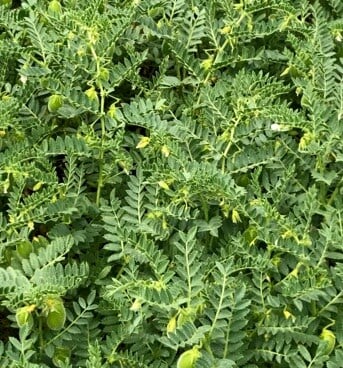Harvesting pulses – Pulse Check meeting tips
Harvester set-up for pulses was discussed at a meeting of the GRDC Northern Pulse Check Discussion Group.

At a recent meeting of the GRDC Northern Pulse Check Discussion Group, harvester set-up for pulses was discussed.
Key points for harvesting pulses are provided below, courtesy of Riverine Plains Silver Sponsors, O’Connors, Bronze Sponsors, Hutcheon and Pearce and also thanks to James Madden, Madden Consulting;
- People have had mixed results with windrowing pulses.
- Desiccation may not be needed this year, as pulses are expected to ripen evenly.
- Each header is different and each season is different. Given the good season, it is expected that pulses will be easier to harvest as the pods are higher off the ground and it should feed in well.
- When setting up the header, belt speed and header angle is important.
- Correct harvest speed in critical to ensure good material flow onto platform to reduce header losses.
- Perforated doors on clean grain elevator help clean sample by letting dirt escape before entering grain tank
- In large crops and light crops, it is important to get the reel at the right position.
- Flex draper fronts can be an advantage when harvesting pulses close to the ground; the use of flex fronts is an advantage over rigid fronts when harvesting on the ground in uneven terrain, on flat ground rigid fronts work very well
- Front setup is very important for crops close to the ground.
- Ensure that for Case IH machines, AAHC (Auto Header Height Control) is set up, calibrated and working. This will reduce wear & tear on the front and feederhouse.
- Check that you have close reel to cutterbar clearance set, but not too close that the fingers can go into the knife.
- Make sure the reel isn’t running too slow or too fast, but gently assisting the crop flow onto the draper mats
- Grain moisture is also important; less grain damage and losses will occur with higher moisture. Don’t let the crop get too dry.
- Be mindful of the time of day when harvesting fragile crops. As when it’s hot and dry you may be at risk of losing yield before it gets into the front. Some crops are better harvested in the cool, when things are tougher.
- Watch for fires when harvesting pulses, regularly blow down any spots on the header where you have friction.
O’Connors have supplied some suggested combine settings for harvesting lentils, chick peas, beans, and lupins for the following Case IH flagship series combines;
- 7010 & 8010
- 7120, 8120 & 9120
- 7230, 8230 & 9230
- 7240, 8240 & 9240
- 7250, 8250 & 9250
- these are only suggested harvesting set-ups and may not suit in all situations or crop conditions.
- In the Suggested Initial Settings the following terms are used against referencing the module set up; SW = Small Wire, LW = Large Wire, LSW = Large Skip Wire, SL= Slotted
For further information please download Case IH’s Suggested Combine Initial Settings 2020 or contact O’Connors at Corowa on 02 6033 1666
John Deere Combine Optimisation
Hutcheon and Pearce have supplied the following S-Series Combine and Front-end Equipment Optimisation information for harvesting soybeans (other pulses will have the same settings, so farmers can use this as a guide).
For further information, please contact Hutcheon and Pearce Finley on (03) 5883 1655.
Author
Kate Coffey
Senior Project Manager Bachelor of Agricultural Economics, Grad Diploma in Financial Administration
25 October 2020
NEWS
Catch up on our project and event news.
-
Livestock
-
People
-
Grains
-
Sustainability

